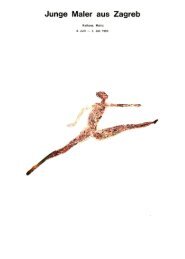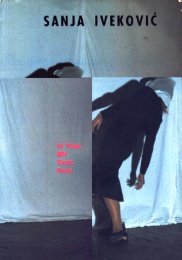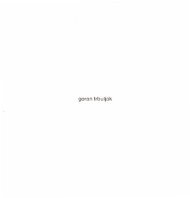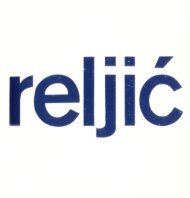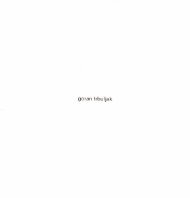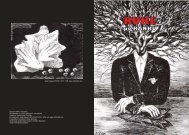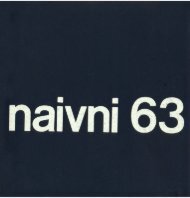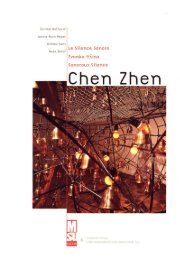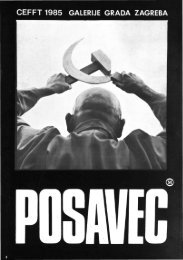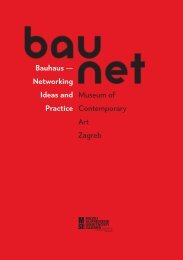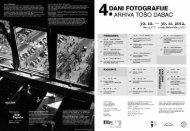The New Art Practice in Yugoslavia, 1966-1978
The New Art Practice in Yugoslavia, 1966-1978
The New Art Practice in Yugoslavia, 1966-1978
- TAGS
- practice
- yugoslavia
- www.msu.hr
Create successful ePaper yourself
Turn your PDF publications into a flip-book with our unique Google optimized e-Paper software.
Vladan Radovanovi<br />
About my Work<br />
Belgrade<br />
Figs. 223-225<br />
A considerable area of the research that I have been do<strong>in</strong>g<br />
comprises approaches closely related to the new trends <strong>in</strong><br />
art (Figs. 223-225). Some of the characteristics of recent<br />
trends (happen<strong>in</strong>g-fluxus, body art, conceptual art) appear as<br />
early as 1955-1957 <strong>in</strong> the works I produced quite <strong>in</strong>dependently<br />
of the <strong>in</strong>fluences and events which were already becom<strong>in</strong>g<br />
topical at the time. <strong>The</strong>se works <strong>in</strong>clude proposals for<br />
performances, description of performances and exercises<br />
(Glass is Taken, Spectacles, Rope and Thumbs, and others,<br />
1956-1957), Develop<strong>in</strong>g One's Own Body (1956) and projects<br />
which centre on self-analysis and the analysis of one's<br />
com<strong>in</strong>g <strong>in</strong>to existence. (Subtraction 1955-1956, Ly<strong>in</strong>g Down<br />
1957, and others). <strong>The</strong> features characteristic of the<br />
abovementioned trends are not, of course, clearly delimited;<br />
the three groups <strong>in</strong>term<strong>in</strong>gle. A feature common to all three<br />
groups is the <strong>in</strong>tegration of several media (visual, phonic,<br />
tactile), the use of texts, and occasionally collage. Research<br />
of this type is cont<strong>in</strong>ued anly later, from 1970 onwards. It<br />
comprises new projects, verbo-plastic-tactile, k<strong>in</strong>etic works and<br />
trens-media (tape-paper, photo and book medium).<br />
Projects for performance <strong>in</strong>cluded «actions» or were a record<br />
of their realization. <strong>The</strong> performances were carried out <strong>in</strong>side<br />
a room, without the social implications found <strong>in</strong> fluxus, or the<br />
destructions found <strong>in</strong> happen<strong>in</strong>gs. Though such performances<br />
were not necessarily classed as art, it was not considered<br />
that they were anti-art either. <strong>The</strong> project as a proposal is<br />
not a report on that accomplished, nor an accomplishment<br />
of that proposed, nor a guarantee of the realization of the<br />
work <strong>in</strong> general. If the project is an outl<strong>in</strong>e for someth<strong>in</strong>g<br />
that, once performed, will become a work which will not<br />
necessarily be carried out, then the very notion of a work is<br />
brought <strong>in</strong>to question. While the reality of a project for a<br />
performance lies <strong>in</strong> po<strong>in</strong>t<strong>in</strong>g out someth<strong>in</strong>g which may rema<strong>in</strong><br />
noth<strong>in</strong>g but a possibility, with exercises it is important to<br />
actually carry out and experience what has been described.<br />
<strong>The</strong> similarity of the second group of projects with body art<br />
lies <strong>in</strong> treat<strong>in</strong>g the body as the material on which work is<br />
performed, and thus the body becomes both subject and object.<br />
This aga<strong>in</strong> was not necessarily classed as art. S<strong>in</strong>ce the<br />
feel<strong>in</strong>g of the body is stressed rather than its visible appearance,<br />
it is even less possible for the subject to be an object for<br />
others. <strong>The</strong> fact of attach<strong>in</strong>g greater importance to the<br />
proposed experience with one's own body than to the<br />
observation of someone else's experience leads to<br />
mono-communicativeness. Otherwise, the impulse to feel one's<br />
body, to feel it as one's own, represents the start<strong>in</strong>g po<strong>in</strong>t<br />
for work. S<strong>in</strong>ce this impulse has a tautological relation to the<br />
already exist<strong>in</strong>g feel<strong>in</strong>g of the body, this relation has only to<br />
be analogized by means of data text and object and<br />
somebody's participation.<br />
In projects of self-analysis and other similar recent research<br />
projects there are, <strong>in</strong> addition to autonomous trends, certa<strong>in</strong><br />
features that can be related to conceptual art.<br />
In Subtraction and Ly<strong>in</strong>g Down the demateralization of the<br />
object is not particularly stressed, s<strong>in</strong>ce these projects were<br />
not conceived as deriv<strong>in</strong>g from the field of plastic arts. It was<br />
considered from the start that they derive from an area ly<strong>in</strong>g<br />
between the art genres and the media. In the first three parts<br />
of Subtraction descriptions are given of the actions, <strong>in</strong>tentions<br />
and states which affect the formal relations, while <strong>in</strong> the fourth<br />
part, the observer is ordered to subtract the concrete contents<br />
which had been added to the subject-matter. In more recent<br />
projects the object has not disappeared, but its position has<br />
been obscured when it acts as both presentation and<br />
realization of the project. Reduced to conventional signs which<br />
only serve to designate and not to <strong>in</strong>fluence, the object is<br />
replaceable by another object as long as it refers to the same<br />
concept. <strong>The</strong> irreplaceability of the concept shows that the<br />
object has been subjected to the concept.<br />
In the trans-media there is a tendency to depersonalize the<br />
artistic genre. <strong>The</strong> media can be reta<strong>in</strong>ed and the related<br />
artistic genres need not be represented, because the simple fact<br />
that we listen to someth<strong>in</strong>g does not necesarily mean that this<br />
belongs to music, literature or the theatre.<br />
Already <strong>in</strong> Subtraction the conceptual approach is most closely<br />
related to the scheme, outl<strong>in</strong>e and idea of the work which has<br />
not, however, been identified with art. <strong>The</strong> expression<br />
«representation» was used for the elements of the scheme which<br />
should «spark off from with<strong>in</strong>., while <strong>in</strong> actual fact, what we<br />
had <strong>in</strong> m<strong>in</strong>d was the representation of the notion (hypotheposis).<br />
After the request for reduction was made, the observer is asked<br />
<strong>in</strong> the fourth part of «Subtraction» to reta<strong>in</strong> that «which is ...<br />
formed <strong>in</strong> the m<strong>in</strong>d., which can be «taken as a cluster of<br />
sense, mean<strong>in</strong>g.. <strong>The</strong> scheme presented at the end shows<br />
the work as a whole, the sett<strong>in</strong>g up of the fourth part on the<br />
basis of the reduction of the previous three, the position and<br />
behaviour of notions with<strong>in</strong> the coord<strong>in</strong>ate system of <strong>in</strong>tensity<br />
and time. However, there is an awareness that this scheme is<br />
only a «material', presentation of a construction which should<br />
be grasped <strong>in</strong> itself: Words <strong>in</strong> themselves are <strong>in</strong>adequate to<br />
direct us to the 'graph of subtraction.. It is easier to spark<br />
of the subtraction from with<strong>in</strong>. This does not have to be done<br />
with the aid of material or through elaboration With<br />
regard to the more recent projects, <strong>in</strong> addition to the idea as a<br />
notion which is a logical creation, I believe that the further we<br />
go towards an <strong>in</strong>dividual piece of work, the more it becomes<br />
a question of ideas as someth<strong>in</strong>g experienced as general<br />
representations, close to the generl mean<strong>in</strong>g: idea image,<br />
appearance.<br />
Self-analysis <strong>in</strong> earlier works has developed <strong>in</strong> later works<br />
<strong>in</strong>to self-confidence, but not <strong>in</strong> the sense of usurp<strong>in</strong>g<br />
uncoditional rights to proclaim somethnig as artistic and<br />
valuable. In Subtraction self-analysis covers everyth<strong>in</strong>g,<br />
start<strong>in</strong>g from the consideration of certa<strong>in</strong> elements of the work<br />
<strong>in</strong> the form of treatises or outl<strong>in</strong>es of possible dialogues with<br />
the audience, to the consideration of the whole work which is<br />
itself <strong>in</strong>cluded <strong>in</strong> the work. In the tape and paper medium,<br />
self-analysis is carried out dur<strong>in</strong>g the general sett<strong>in</strong>g up of the<br />
work and medium. Listen<strong>in</strong>g to the phonic-sematic model <strong>in</strong><br />
time and space is used to develop one's awareness of listen<strong>in</strong>g,<br />
time and space. <strong>The</strong> new awareness consists <strong>in</strong> recogniz<strong>in</strong>g<br />
the frequently overlooked reality of the «here. and ..now'<br />
which, together with the equivalent audio-semantic resources,<br />
create the necessary relations and function with<strong>in</strong> the context<br />
of work as a system.<br />
<strong>The</strong> l<strong>in</strong>guistic nature of these works derives from the fact that<br />
they are ma<strong>in</strong>ly discursive. Here too the role of «speech. was<br />
«to raise the shemes which were produced to determ<strong>in</strong>e a<br />
work of art» (K. Mille), and to facilitate the apperance of the<br />
tautological component which emerges when mean<strong>in</strong>g and<br />
function co<strong>in</strong>cide. But the fact that their elements me2n<br />
someth<strong>in</strong>g. that they are of a l<strong>in</strong>guistic nature, and that the<br />
works themselves, by deal<strong>in</strong>g with the articulative, can be<br />
classed under «art as language., does not mean that art <strong>in</strong><br />
general is language, because it also conta<strong>in</strong>s efements which<br />
have an immediate effect and are of a factual nature.<br />
Already used <strong>in</strong> the Portrait-Landscape (1954) and Subtraction,<br />
tautology appears <strong>in</strong> the more recent works as a unit of work,<br />
and not as a specific type of work <strong>in</strong> relation to art, not <strong>in</strong> the<br />
def<strong>in</strong>ition of art accord<strong>in</strong>g to which «a special world of art is<br />
art» (Joseph Kosuth). While tautological systems also cover<br />
their own def<strong>in</strong>itions of symbols, a work of art is a tautology<br />
only when all the def<strong>in</strong>itions are comprised with<strong>in</strong> the work,<br />
which is rare. <strong>The</strong> extension of the tautological to the def<strong>in</strong>ition<br />
of art leads to even greater difficulties. In the past, the<br />
connotation of the word «art» changed, but it was never<br />
replaced by a different expression. This replacement is achieved<br />
already by the def<strong>in</strong>ition accord<strong>in</strong>g to which «art is a def<strong>in</strong>ition<br />
of art». S<strong>in</strong>ce art has never been this, the word «art. as used<br />
<strong>in</strong> the above def<strong>in</strong>ition does not refer to art, this def<strong>in</strong>ition only<br />
says that the nature of «someth<strong>in</strong>g. is its own proper def<strong>in</strong>ition,<br />
but not that this is art. Ow<strong>in</strong>g to the dubious nature of such<br />
operations which have become quite widespread, I thought it<br />
important to adopt an approach which would make my work<br />
57



